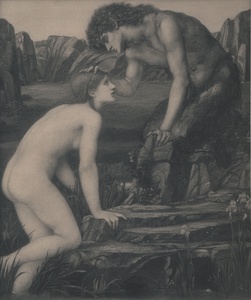| Method | Platinotype |
| Artist | Frederick Hollyer after Sir Edward Coley Burne-Jones |
| Published | Copyright, Fredk. Hollyer, 9, Pembroke Square, Kensington. [c. 1890's] |
| Dimensions | Image and sheet 305 x 255 mm |
| Notes |
A scarce Fredrick Hollyer platinotype of Burne-Jones' Pan and Psyche. The painting upon which this engraving is based is now in the Fogg Art Museum, Harvard University. A platinotype after Burne-Jones' 'Pan and Psyche' depicting Psyche's encounter with Pan, the wilderness god. When Psyche is distraught over the loss of her love Cupid, she attempts suicide in a river. She survives and the god Pan offers her comfort and advice. Here, Pan discovers her, and recognises her passion and longing. Burne-Jones presents Psyche emerging from the river, with Pan empathetically placing his hand upon her head. Burne-Jones painted this version of Pan and Psyche after his lover, Maria Zambaco, attempted to throw herself in Regent's Canal in a distraught suicide attempt. Burne-Jones had an intense affair with Maria but could not bring himself to leave his children or his wife Georgie. Maria had grown increasingly desperate and, upon the realisation that he would not leave his family, presented Burne-Jones with a sufficient amount of Laudanum to kill them both. In response to his refusal, she ran to the river and he was forced to wrestle her to the ground. Frederick Hollyer (1837 - 1933) was a mezzotint engraver and famed photographic reproducer of Victorian paintings. Born in London, Frederick was the son of the line engraver Samuel Hollyer. In his junior years he flirted with engraving, and it was in this practise that he received renown for a series of mezzotints he produced after Edwin Landseer. It was his interest, and subsequent pioneering in the field of photography that defined Hollyer's career. He began by making albumen prints from collodion negatives but then was fiercely active in the development of the platinotype. The method of printing, combined with a dry gelatin plate, as opposed to an emulsified version, results in a very high quality matte finish. The prints display a greater tonal subtlety and formal veracity; they are also far more durable. In the 1870's, Hollyer established a business in photographic reproduction based upon this medium and, under the patronage of Frederick Leighton, specialised in the copying of Pre-Raphaelite painting and drawing. These reproductions were used in books and magazines, and thus contributed hugely to the popularity of the movement. A fact that was acknowledged in Hollyer's obituary by The Times when they wrote that he did as much for the Brotherhood with his prints as John Ruskin did with his pen. Sir Edward Coley Burne-Jones, 1st Bt (1833-1898) was a painter and designer closely associated with the later phase of the Pre-Raphaelite movement. Burne-Jones met William Morris as an undergraduate of Exeter college, Oxford, whilst studying for a degree in theology. The pair went on to work very closely together on numerous decorative arts projects including stained glass windows, tapestries and illustrations. Originally intending to become a church minister, Burne-Jones never finished his degree, choosing instead to pursue an artistic career under the influence of Dante Gabriel Rossetti. Rossetti heavily inspired his early work, but by the 1860's his idiosyncratic style was beginning to develop. His mature work, however different in total effect, is rich in conscious echoes of Botticelli, Mantegna and other Italian masters of the Quattrocento. Thusly, Burne Jones' later paintings of classical and medieval subjects are some of the most iconic of the Pre-Raphaelite movement. He was at the height of his popularity during the 1880's, though his reputation began to decline with the onset of the Impressionists. He was created a baronet in 1894, when he formally hyphenated his name. Condition: Water stain to lower left corner on Psyche's legs. Fredrick Hollyer stamp on verso. Framed in a period oak frame. |
| Framing | framed |
| Price | £575.00 |
| Stock ID | 52213 |

